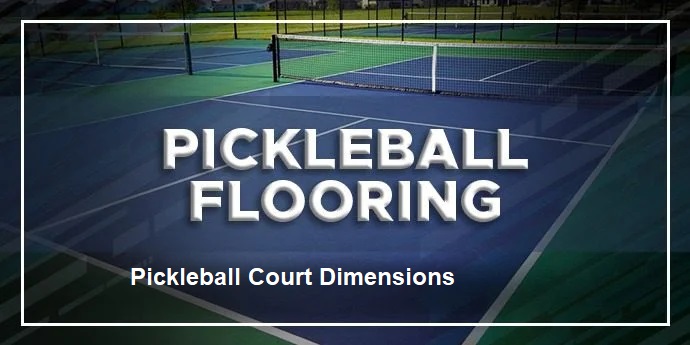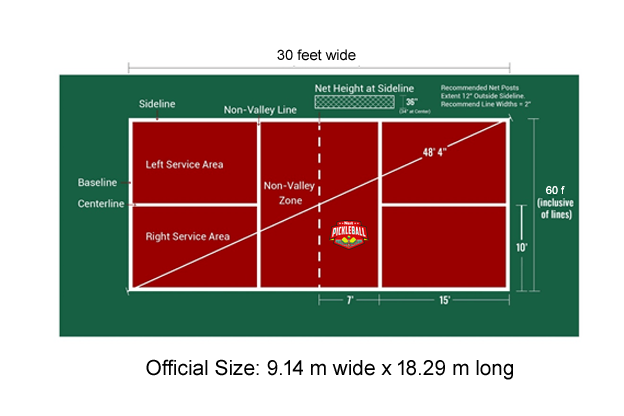Pickleball Court Dimensions: Everything You Need to Know Before You Play

Pickleball Court Dimensions has taken the world by storm — it’s fast, fun, and easy to learn. What started as a backyard pastime has become one of the fastest-growing sports in America and beyond. But whether you’re setting up your own court or just curious about the game’s layout, understanding pickleball court Dimension is absolutely essential.
If you’ve ever wondered how big a pickleball court Dimension is, how it compares to tennis or badminton, and what each section of the court means, this guide breaks it all down — clearly and casually, like a pro explaining it to a friend.
What Are the Standard Pickleball Court Dimensions?
Let’s start with the basics. According to official USA Pickleball Association (USAPA) regulations, a standard pickleball court Dimensions measures 20 feet wide by 44 feet long for both singles and doubles play. Yes — the same size works for both! Unlike tennis, where singles and doubles have different court widths, pickleball keeps it simple.
The court is divided by a net that stands 36 inches high at the sidelines and 34 inches high in the center. The slight dip in the middle gives the game its signature rhythm, allowing for more precise dinks and volleys close to the net.
Now, beyond these numbers, the court is divided into different zones — each with its own purpose. These include:
- The Non-Volley Zone (NVZ), commonly known as the kitchen, which is 7 feet deep on both sides of the net.
- The Service Areas, which make up the rest of the court behind the kitchen line, divided into left and right service boxes.
- The Baseline, which marks the end of the court — 22 feet from the net.
If you’re building or marking a pickleball court Dimensions , these measurements are non-negotiable. The 20×44-foot playing surface is universal, whether indoors or outdoors, professional or recreational.
The Importance of the Non-Volley Zone (The “Kitchen”)

Ask any pickleball court Dimension player, and they’ll tell you — the “kitchen” is where the real magic happens. This 7-foot-deep zone on each side of the net might look small, but it completely changes how the game is played.
Players are not allowed to volley (hit the ball out of the air) while standing inside the kitchen. You can step into it only after the ball bounces. This rule keeps the game strategic rather than power-driven. It prevents players from crowding the net and smashing every shot, making rallies more thoughtful and fun.
The kitchen line itself is part of the non-volley zone, so even touching it during a volley counts as a fault. When you’re measuring and painting your court, be precise — those 7 feet matter! Many casual players underestimate how strict this rule is until they lose a few points because their toe grazed the line.
A fun fact: The kitchen is inspired by badminton’s “short service line,” but in pickleball, it adds a unique layer of challenge. You’ll often hear players say, “Stay out of the kitchen!” — and they mean it.
Service Areas and Baselines: Where the Game Begins
Behind the kitchen are two equal halves known as the service courts. These areas are where you serve and receive from. Each side is 10 feet wide (half of the total width) and 15 feet deep (from the kitchen line to the baseline).
When serving, you must stand behind the baseline, which runs parallel to the net. The serve must land in the diagonally opposite service box, clearing the non-volley zone. This diagonal rule keeps the gameplay fair and ensures both players or teams move strategically around the court.
The baseline also plays a critical role in judging in or out calls. If the ball lands on the baseline, it’s considered in. That means accurate court markings are crucial — even a few inches off can make or break a game.
In doubles play, understanding service rotation is key, and the clear division of the court makes it easier for players to maintain positions and follow the serving sequence without confusion.
Pickleball Court Dimensionvs. Tennis Court: Size and Space Differences
One of the most common questions new players ask is how a pickleball court compares to a tennis court. The answer might surprise you: a pickleball court One of the most common questions new players ask is how a pickleball court compares to a tennis court. The answer might surprise you: a pickleball court Dimensions is much smaller — roughly one-fourth the size of a standard tennis court.
Here’s the breakdown:
- Pickleball court Dimensions : 20 x 44 feet
- Tennis court: 36 x 78 feet (for doubles)
This size difference means you can fit four pickleball court Dimensions inside one tennis court with space to spare. Because of this efficiency, many community parks and sports centers have started converting underused tennis courts into pickleball facilities.
Another difference lies in the net height and design. Tennis nets are higher (42 inches at the posts and 36 in the center), while pickleball nets are slightly shorter (36 inches at posts, 34 in center). This lower net allows for longer rallies and makes the sport accessible to all ages and fitness levels.
The smallerpickleball court dimensions also make pickleball easier on the joints. There’s less running, quicker reaction time, and a focus on skill rather than brute force — which is a big part of its growing appeal among players of all ages.
Setting Up a Pickleball Court Dimensions: Space and Markings
If you’re building your own court or converting an existing space, knowing the total area is just as important as knowing the playing dimensions. For comfortable play, you need a minimum total area of 30 feet by 60 feet, which provides enough space for movement, safety zones, and out-of-bounds areas.
For competitive or professional setups, a recommended area of 34 feet by 64 feet is ideal. This extra room allows for player movement, fencing, and spectator seating if needed.
When marking the court:
- Use 2-inch wide lines for all boundaries.
- Paint the non-volley zone (kitchen) 7 feet from the net.
- Clearly mark the centerline that divides the left and right service areas.
Pickleball courtDimensions surfaces can be asphalt, concrete, or acrylic — similar to tennis courts. Many players prefer a slightly textured surface for better traction and ball bounce control. And if you’re converting a tennis court, temporary pickleball lines or portable nets are an easy way to get started.
Indoor vs. Outdoor Pickleball Court Dimensions
The good news? The Pickleball court dimensions remain the same whether you play indoors or outdoors — 20×44 feet. However, there are a few differences worth noting.
Indoor courts usually have smoother surfaces and less wind interference, allowing for more controlled play. Outdoor courts, on the other hand, must account for weather, sunlight, and wind, so surface materials and boundary spacing become more important.
Outdoor pickleballs also differ — they have smaller holes and are slightly heavier to resist wind, while indoor balls are lighter and have larger holes for smoother indoor play. Still, regardless of where you play, the court layout remains consistent, which helps maintain the game’s universal rules and easy adaptability.
If you’re setting up an outdoor court, consider positioning it north-south to reduce sun glare during morning and evening matches. This is a small but smart detail that experienced players swear by.
Why Understanding Court Dimensions Improves Your Game
Knowing the exact pickleball court dimensions isn’t just about following the rules — it can genuinely improve how you play. When you understand the distances and zones, your movement, positioning, and shot selection become more intentional.
For example, knowing that the kitchen extends exactly 7 feet from the net helps you gauge when to move forward for a dink or when to hang back for a drive shot. Similarly, understanding how deep the baseline is can improve your serve consistency and help you stay within bounds during long rallies.
Many experienced players also use the lines strategically — not just as boundaries but as reference points for angles, shot depth, and defensive positioning. In short, the more familiar you are with the court layout, the more control and confidence you’ll have during every game.
Conclusion: The Perfect Court, The Perfect Game
So, what’s the takeaway? A pickleball court Dimensions measures 20 feet wide by 44 feet long, with a 7-foot non-volley zone on each side of the net and a net height of 36 inches at the posts, 34 inches at the center. Simple, efficient, and perfectly designed for fast-paced, strategic gameplay.
These compact dimensions make pickleball one of the most inclusive and exciting sports today — easy to learn, quick to play, and adaptable to almost any space. Whether you’re building a backyard court or joining your local rec center, understanding these measurements ensures you’re playing the game the right way.
Next time you step onto the court, you’ll not only know the numbers — you’ll appreciate how perfectly they come together to create one of the most enjoyable sports on the planet.



